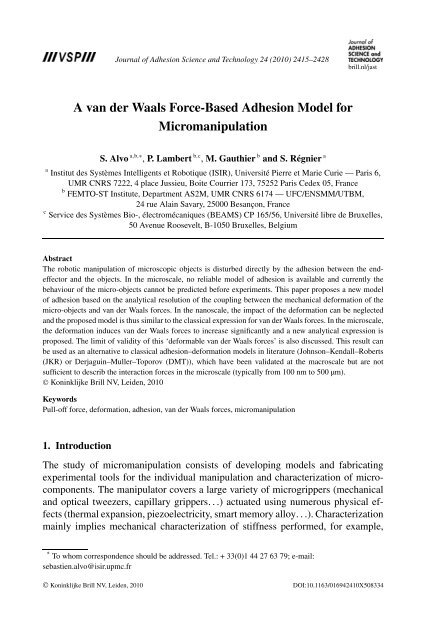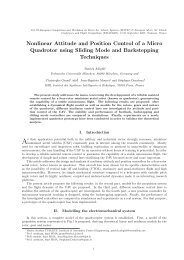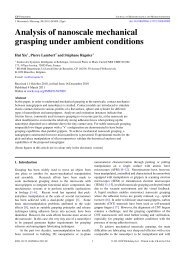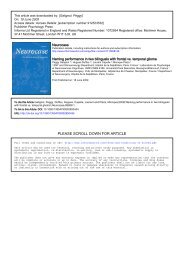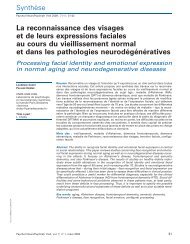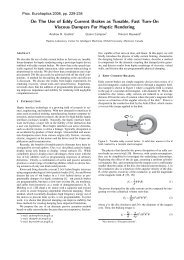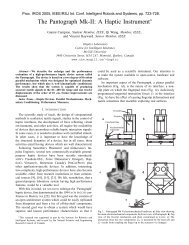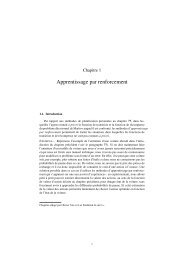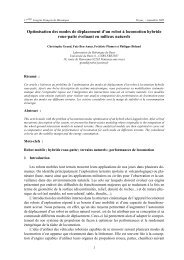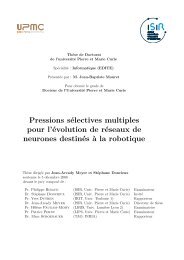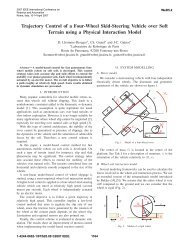A van der Waals Force-Based Adhesion Model for Micromanipulation
A van der Waals Force-Based Adhesion Model for Micromanipulation
A van der Waals Force-Based Adhesion Model for Micromanipulation
You also want an ePaper? Increase the reach of your titles
YUMPU automatically turns print PDFs into web optimized ePapers that Google loves.
Journal of <strong>Adhesion</strong> Science and Technology 24 (2010) 2415–2428<br />
brill.nl/jast<br />
A <strong>van</strong> <strong>der</strong> <strong>Waals</strong> <strong>Force</strong>-<strong>Based</strong> <strong>Adhesion</strong> <strong>Model</strong> <strong>for</strong><br />
<strong>Micromanipulation</strong><br />
S. Alvo a,b,∗ , P. Lambert b,c , M. Gauthier b and S. Régnier a<br />
a Institut des Systèmes Intelligents et Robotique (ISIR), Université Pierre et Marie Curie — Paris 6,<br />
UMR CNRS 7222, 4 place Jussieu, Boite Courrier 173, 75252 Paris Cedex 05, France<br />
b FEMTO-ST Institute, Department AS2M, UMR CNRS 6174 — UFC/ENSMM/UTBM,<br />
24 rue Alain Savary, 25000 Besançon, France<br />
c Service des Systèmes Bio-, électromécaniques (BEAMS) CP 165/56, Université libre de Bruxelles,<br />
50 Avenue Roosevelt, B-1050 Bruxelles, Belgium<br />
Abstract<br />
The robotic manipulation of microscopic objects is disturbed directly by the adhesion between the endeffector<br />
and the objects. In the microscale, no reliable model of adhesion is available and currently the<br />
behaviour of the micro-objects cannot be predicted be<strong>for</strong>e experiments. This paper proposes a new model<br />
of adhesion based on the analytical resolution of the coupling between the mechanical de<strong>for</strong>mation of the<br />
micro-objects and <strong>van</strong> <strong>der</strong> <strong>Waals</strong> <strong>for</strong>ces. In the nanoscale, the impact of the de<strong>for</strong>mation can be neglected<br />
and the proposed model is thus similar to the classical expression <strong>for</strong> <strong>van</strong> <strong>der</strong> <strong>Waals</strong> <strong>for</strong>ces. In the microscale,<br />
the de<strong>for</strong>mation induces <strong>van</strong> <strong>der</strong> <strong>Waals</strong> <strong>for</strong>ces to increase significantly and a new analytical expression is<br />
proposed. The limit of validity of this ‘de<strong>for</strong>mable <strong>van</strong> <strong>der</strong> <strong>Waals</strong> <strong>for</strong>ces’ is also discussed. This result can<br />
be used as an alternative to classical adhesion–de<strong>for</strong>mation models in literature (Johnson–Kendall–Roberts<br />
(JKR) or Derjaguin–Muller–Toporov (DMT)), which have been validated at the macroscale but are not<br />
sufficient to describ the interaction <strong>for</strong>ces in the microscale (typically from 100 nm to 500 µm).<br />
© Koninklijke Brill NV, Leiden, 2010<br />
Keywords<br />
Pull-off <strong>for</strong>ce, de<strong>for</strong>mation, adhesion, <strong>van</strong> <strong>der</strong> <strong>Waals</strong> <strong>for</strong>ces, micromanipulation<br />
1. Introduction<br />
The study of micromanipulation consists of developing models and fabricating<br />
experimental tools <strong>for</strong> the individual manipulation and characterization of microcomponents.<br />
The manipulator covers a large variety of microgrippers (mechanical<br />
and optical tweezers, capillary grippers...) actuated using numerous physical effects<br />
(thermal expansion, piezoelectricity, smart memory alloy...). Characterization<br />
mainly implies mechanical characterization of stiffness per<strong>for</strong>med, <strong>for</strong> example,<br />
* To whom correspondence should be addressed. Tel.: + 33(0)1 44 27 63 79; e-mail:<br />
sebastien.alvo@isir.upmc.fr<br />
© Koninklijke Brill NV, Leiden, 2010 DOI:10.1163/016942410X508334
2416 S. Alvo et al. / Journal of <strong>Adhesion</strong> Science and Technology 24 (2010) 2415–2428<br />
with an atomic <strong>for</strong>ce microscope. The major industrial perspective of micromanipulation<br />
is to develop reliable micro-assembly techniques, based on robotic assembly<br />
or self-assembly. Both require adequate models to estimate the surface <strong>for</strong>ces disturbing<br />
the micromanipulation.<br />
The goal of developing models at the microscale may be questioned <strong>for</strong> many<br />
reasons:<br />
1. The task is huge and the <strong>for</strong>ces dominating at the micro- and nanoscales can<br />
be modeled only partially: <strong>for</strong> example, some of them cannot be modeled in a<br />
quantitative way (e.g., hydrogen bonds) suitable <strong>for</strong> robotics purpose, and most<br />
of proposed models are valid only at equilibrium (at least all the models based<br />
on the <strong>der</strong>ivation of surface or potential energies);<br />
2. It is impossible sometimes to know the parameters involved in the existing models,<br />
<strong>for</strong> example, the distribution of electrical charges on a dielectric oxide layer;<br />
3. In the micro- and nanoscales, the physical measurements suffer from a very<br />
large experimental scatter, which makes the models’ refinements questionable.<br />
According to individual’s experience, experimental measurements are typically<br />
obtained with an error greater than some tens of percents.<br />
Nevertheless the use of — even basic — models helps the microrobotician to<br />
roughly describe the micro-objects behavior and design best grippers and tools.<br />
Classical adhesion models like JKR [1], DMT [2] and Maugis–Dugdale [3] are usually<br />
proposed to study adhesion in micromanipulation [4]. These models are based<br />
on the elastic de<strong>for</strong>mation of two solids in contact (e.g., microcomponent/gripper<br />
in micromanipulation) and cannot match the experimental data very well at the microscale.<br />
We propose, there<strong>for</strong>e, a new analytical model taking into account the elastic<br />
de<strong>for</strong>mation and the <strong>van</strong> <strong>der</strong> <strong>Waals</strong> <strong>for</strong>ces as the main source of adhesion [5, 6].<br />
Capillary condensation is supposed to play a major role in humid environments [7],<br />
but as a preliminary step in this paper, we will only consi<strong>der</strong> dry environments in<br />
which capillary condensation can be neglected. Moreover, materials used are supposed<br />
to be non-conductive and neutral so electrostatic <strong>for</strong>ces are not consi<strong>der</strong>ed.<br />
This paper is organized in the following sections. Section 2 presents the coupled<br />
problem of adhesion and de<strong>for</strong>mation and the innovative iterative scheme used to<br />
solve it. Section 3 recalls the basics of <strong>van</strong> <strong>der</strong> <strong>Waals</strong> (vdW) <strong>for</strong>ces and presents the<br />
vdW interaction between a truncated sphere and a plane, which is used in the iterative<br />
resolution. Section 4 describes the iterative scheme which provides an implicit<br />
expression <strong>for</strong> the <strong>for</strong>ce. Two analytical approximations are also provided which<br />
are valid in nano- and microscales, respectively. Finally, Section 5 suggests further<br />
work and conclusions are drawn in Section 6.
S. Alvo et al. / Journal of <strong>Adhesion</strong> Science and Technology 24 (2010) 2415–2428 2417<br />
2. Problem Description<br />
2.1. The Lack of <strong>Adhesion</strong> <strong>Model</strong> <strong>for</strong> <strong>Micromanipulation</strong><br />
The main idea of this paper is to extend the existing model to the microscale. On the<br />
one hand, JKR, DMT or Maugis models are usually used to compute pull-off <strong>for</strong>ces<br />
(<strong>for</strong>ce needed to split two objects in contact). They are computed with global energy<br />
calculation and their efficiency is well established at macroscale [8] but they are<br />
not correlated with experimental microscale measurements. These models take into<br />
account the impact of the de<strong>for</strong>mation on the pull-off <strong>for</strong>ce but they are restricted<br />
to sphere/plane contact and cannot be applied to more complex geometries (e.g.,<br />
parallelepipedic objects) usually used in microhandling [9].<br />
On the other hand, atomic models based on the Hamaker computation could be<br />
extended from nanoscale to microscale. So <strong>van</strong> <strong>der</strong> <strong>Waals</strong> theory could be used<br />
to predict adhesion phenomena [6] <strong>for</strong> any kind of geometry (see Section 3.1).<br />
However, in the microscale, this theory un<strong>der</strong>estimates pull-off <strong>for</strong>ces. Moreover,<br />
it does not take into account the de<strong>for</strong>mation which has a significant impact in<br />
microscale.<br />
An Atomic <strong>Force</strong> Microscope (AFM) with a cantilever whose stiffness is 0.3 N/m<br />
has been used to measure pull-off <strong>for</strong>ces. Measurements have been carried out in<br />
a temperature and humidity controlled environment to minimize the capillary condensation.<br />
For example, the measured pull-off <strong>for</strong>ce is 1.6 ± 0.6 µN when a glass<br />
sphere with 10 µm diameter contacts a glass substrate. JKR and DMT theories predict<br />
a larger <strong>for</strong>ce of 8.0 µN and 10.7 µN and the <strong>van</strong> <strong>der</strong> <strong>Waals</strong> theory predicts a<br />
smaller value of 0.6 µN. New investigation should be per<strong>for</strong>med in or<strong>der</strong> to predict<br />
pull-off <strong>for</strong>ces better in the microscale.<br />
So new models are necessary to un<strong>der</strong>stand the behavior of objects whose size<br />
is between 100 nm and 100 µm. This paper proposes a way to take into account the<br />
de<strong>for</strong>mation of the object in the calculation of <strong>van</strong> <strong>der</strong> <strong>Waals</strong> <strong>for</strong>ces.<br />
2.2. A New Method <strong>for</strong> <strong>Adhesion</strong> <strong>Model</strong>ing<br />
The sum of <strong>van</strong> <strong>der</strong> <strong>Waals</strong> <strong>for</strong>ces applied by an object to another one depends on<br />
their contact surface and can also be consi<strong>der</strong>ed as a global <strong>for</strong>ce which induces<br />
a de<strong>for</strong>mation. This de<strong>for</strong>mation increases the contact surface and the global <strong>van</strong><br />
<strong>der</strong> <strong>Waals</strong> <strong>for</strong>ces too. This coupled problem can be seen as an algorithm that uses<br />
sequentially two models (Fig. 1). The first one computes <strong>van</strong> <strong>der</strong> <strong>Waals</strong> <strong>for</strong>ces according<br />
to the object shape. The other one computes de<strong>for</strong>mation shape according<br />
to an external load. An iterative calculation is able to converge to the physical equilibrium.<br />
This generic principle can be applied to calculate or simulate adhesion <strong>for</strong>ces <strong>for</strong><br />
a large variety of geometries. However, this paper focuses on the analytical expression<br />
applied to sphere/plane contact based on an analytical expression <strong>for</strong> the <strong>van</strong><br />
<strong>der</strong> <strong>Waals</strong> <strong>for</strong>ces and a de<strong>for</strong>mation model via the Hertz theory. For more complex<br />
geometries including roughness [10], the calculation of the <strong>van</strong> <strong>der</strong> <strong>Waals</strong> <strong>for</strong>ces
2418 S. Alvo et al. / Journal of <strong>Adhesion</strong> Science and Technology 24 (2010) 2415–2428<br />
Figure 1. Algorithm proposed <strong>for</strong> calculating the adhesion <strong>for</strong>ce between two objects using the coupling<br />
between de<strong>for</strong>mation and <strong>van</strong> <strong>der</strong> <strong>Waals</strong> <strong>for</strong>ces.<br />
should be replaced by a numerical calculation, and another de<strong>for</strong>mation model<br />
should be consi<strong>der</strong>ed (e.g., [11] <strong>for</strong> axisymmetric shapes) or modeled via finite<br />
element method.<br />
3. <strong>Model</strong>ing <strong>Adhesion</strong> with <strong>van</strong> <strong>der</strong> <strong>Waals</strong> <strong>Force</strong>s <strong>for</strong> Simple Rigid<br />
Geometries<br />
The first step in the calculation is to calculate the <strong>van</strong> <strong>der</strong> <strong>Waals</strong> <strong>for</strong>ces on a de<strong>for</strong>med<br />
object. A pairwise summation of the energy given by the Lennard–Jones<br />
potential leads to classical expression <strong>for</strong> the <strong>van</strong> <strong>der</strong> <strong>Waals</strong> <strong>for</strong>ces. Computation<br />
<strong>for</strong> simple shape objects attracted by a plane is carried out here as an example<br />
which can be applied to any kind of geometry.<br />
3.1. The Lennard–Jones Potential and the Hamaker Approximation<br />
The Lifshitz theory consi<strong>der</strong>s ‘dance of charges’ coupled with relativistic effects<br />
[12] to calculate electrodynamic free energy that is at the origin of <strong>van</strong> <strong>der</strong> <strong>Waals</strong><br />
<strong>for</strong>ces. It is commonly approximated using the Lennard–Jones potential:<br />
) 12 ( ) 6 r0<br />
− 2ε 0 . (1)<br />
(<br />
r0<br />
φ(r)= ε 0<br />
r<br />
r<br />
This potential represents the interaction between two neutral atoms (or molecules)<br />
separated by a distance r (Fig. 2). r 0 is the equilibrium distance when the <strong>for</strong>ce<br />
F =−∂φ/∂r (Fig. 3) is null and ε 0 is the corresponding energy. The 1/r 12 term
S. Alvo et al. / Journal of <strong>Adhesion</strong> Science and Technology 24 (2010) 2415–2428 2419<br />
Figure 2. Comparison of Lennard–Jones potential (solid line) and 1/r 6 potential (dashed line).<br />
Figure 3. Comparison of <strong>for</strong>ces <strong>der</strong>ived from the Lennard–Jones potential (solid line) and from the<br />
1/r 6 potential (dashed line).<br />
describes the strong repulsion that appears when the two atoms are closer than r 0 .<br />
For r>r 0 , the Lennard–Jones potential is usually approximated by the 1/r 6 term<br />
(Fig. 2):<br />
φ(r)=− C r 6 , where C = 2ε 0r 6 0 . (2)<br />
<strong>Adhesion</strong> <strong>for</strong>ces are computed by a pairwise summation of the Lennard–Jones<br />
energies. Consi<strong>der</strong>ing molecular densities of materials, the discrete summation can<br />
be replaced with an integral. This method is commonly called the Hamaker approximation<br />
[13] which is summarized very well in [14].
2420 S. Alvo et al. / Journal of <strong>Adhesion</strong> Science and Technology 24 (2010) 2415–2428<br />
Figure 4. Notations used <strong>for</strong> the first step of <strong>van</strong> <strong>der</strong> <strong>Waals</strong> <strong>for</strong>ces calculation: attraction <strong>for</strong>ce between<br />
a molecule and a rigid, infinite plane.<br />
3.2. Interaction between a Molecule and an Infinite Plane<br />
The first step in computation of the <strong>van</strong> <strong>der</strong> <strong>Waals</strong> <strong>for</strong>ces is to sum every pairwise<br />
energy between the plane and a molecule of the second object. The <strong>van</strong> <strong>der</strong> <strong>Waals</strong><br />
<strong>for</strong>ces have a short cut-off radius so the plane can be consi<strong>der</strong>ed as infinite without<br />
any influence on the result. Then, using notations of Fig. 4 and consi<strong>der</strong>ing a molecular<br />
density β 1 <strong>for</strong> the plane 1 , the adhesion energy π p between a molecule and<br />
a plane can be <strong>for</strong>mulated as below:<br />
∫<br />
−C<br />
π p (z) = β 1<br />
1<br />
r 6 d 1 =− πCβ 1<br />
6z 3 . (3)<br />
3.3. Interaction between a Sphere and an Infinite Plane<br />
Now the second part of the calculation can be per<strong>for</strong>med by consi<strong>der</strong>ing a molecular<br />
density β 2 <strong>for</strong> the second object (a sphere of radius R). For sphere and plane, the<br />
energy of interaction is:<br />
∫<br />
sp = β 1 β 2 − πC<br />
2<br />
6z 3 d 2. (4)<br />
The Hamaker constant A = π 2 Cβ 1 β 2 appears in the <strong>for</strong>mulation.<br />
The sphere studied is supposed to be larger than its distance from the plane (assumed<br />
to be r 0 = 0.3 nm). So <strong>for</strong> R ≫ r 0 the <strong>for</strong>ce that is <strong>der</strong>ived from the potential<br />
of equation (4) is:<br />
F sp =− AR<br />
6r0<br />
2 . (5)
S. Alvo et al. / Journal of <strong>Adhesion</strong> Science and Technology 24 (2010) 2415–2428 2421<br />
Figure 5. Integration of <strong>van</strong> <strong>der</strong> <strong>Waals</strong> <strong>for</strong>ces between a truncated sphere and an infinite plane.<br />
3.4. Interaction between a Truncated Sphere and an Infinite Plane<br />
We consi<strong>der</strong> a truncated sphere which represents the volume of a sphere of radius R<br />
where the cap with a δ height has been removed (see Fig. 5). The planar surface of<br />
the truncated sphere is at a distance r 0 from the plane. Integral of equation (4) has<br />
now to be computed with a modified 2 described in Fig. 5. The volume 2 extends<br />
from ξ = δ to 2R <strong>for</strong> the truncated sphere rather than from 0 <strong>for</strong> the full sphere.<br />
Thus, still consi<strong>der</strong>ing non-atomic sized spheres (R ≫ r 0 ) and little de<strong>for</strong>mations<br />
(R ≫ δ), a new expression <strong>for</strong> the <strong>van</strong> <strong>der</strong> <strong>Waals</strong> <strong>for</strong>ces can be <strong>for</strong>mulated as:<br />
F s ′ p =− AR(r 0 + 2δ)<br />
6r0<br />
3 . (6)<br />
The first term of this <strong>for</strong>ce is equal to the <strong>for</strong>ce between a full R-radius sphere<br />
and a plane seen in equation (5). Consi<strong>der</strong>ing that δ ≪ R, theterm(ARδ)/(3r0 3)<br />
represents the <strong>for</strong>ce due to a cylin<strong>der</strong> whose radius corresponds to the truncated part<br />
of the sphere. The increase of the contact surface between a sphere and a truncated<br />
sphere induces an increase of the <strong>van</strong> <strong>der</strong> <strong>Waals</strong> <strong>for</strong>ces despite the reduction of the<br />
volume.<br />
The <strong>for</strong>ce computed in equation (6) is used in our coupled model to represent<br />
the <strong>van</strong> <strong>der</strong> <strong>Waals</strong> <strong>for</strong>ces applied to a de<strong>for</strong>med object. The <strong>van</strong> <strong>der</strong> <strong>Waals</strong> <strong>for</strong>ces<br />
computation consequently consi<strong>der</strong>s that the plane is rigid.<br />
4. Sphere De<strong>for</strong>mation un<strong>der</strong> <strong>van</strong> <strong>der</strong> <strong>Waals</strong> <strong>Force</strong>s<br />
A de<strong>for</strong>mation model is needed <strong>for</strong> the second phase of the algorithm presented in<br />
Fig. 1. In the case of a contact between a sphere and a plane, de<strong>for</strong>mation according<br />
to load can be computed via the Hertz theory.
2422 S. Alvo et al. / Journal of <strong>Adhesion</strong> Science and Technology 24 (2010) 2415–2428<br />
Figure 6. Sketch of a sphere/plane contact.<br />
4.1. Hertz Contact <strong>Model</strong>ing<br />
This model which defines the contact surface is the basis <strong>for</strong> the other models well<br />
known in adhesion modeling (JKR and DMT). It computes the radius of contact a<br />
and the penetration δ <strong>for</strong> two spheres pressed together with a <strong>for</strong>ce F (Fig. 6). Hertz<br />
model does not consi<strong>der</strong> adhesion directly. This model is based on a geometrical<br />
and mechanical analysis un<strong>der</strong> three assumptions:<br />
• Contact radius a is small compared to the radii of spheres;<br />
• There is no friction at the interface;<br />
• There is no tensile stress in the contact area.<br />
Elastic properties of the ith material are E i (Young’s modulus) and ν i (Poisson’s<br />
coefficient). The modified Young’s modulus E ∗ is defined as:<br />
1<br />
E ∗ = 1 − ν2 1<br />
+ 1 − ν2 2<br />
. (7)<br />
E 1 E 2<br />
So in case of a sphere/plane contact, the contact radius a and penetration depth δ<br />
can be calculated via Hertz theory:<br />
a 3 =− 3 RF<br />
4 E ∗ , (8)<br />
δ = a2<br />
R . (9)<br />
4.2. Computation of a <strong>Model</strong> Including De<strong>for</strong>mation <strong>for</strong> a Sphere/Plane Contact<br />
We assume that the de<strong>for</strong>med sphere can be seen as a truncated sphere which is<br />
described in Section 3.4. At every step of the algorithm, <strong>van</strong> <strong>der</strong> <strong>Waals</strong> <strong>for</strong>ces F n<br />
are calculated by equation (6) and the contact radius a n is given by the Hertz theory
S. Alvo et al. / Journal of <strong>Adhesion</strong> Science and Technology 24 (2010) 2415–2428 2423<br />
(equation (8)). The penetration into the plane δ n is linked to the contact radius a n<br />
by equation (9). So equation (6) can be rewritten as:<br />
F n =− A(r 0R + 2an 2)<br />
6r0<br />
3 . (10)<br />
At the initial step of the algorithm, the contact radius is consi<strong>der</strong>ed as null, i.e.,<br />
a 0 = 0. For all steps n, equation (8) implies:<br />
( 3R<br />
a n+1 =−<br />
4E ∗ ) 1/3<br />
F 1/3<br />
n . (11)<br />
Consi<strong>der</strong>ing equation (10), a sequence (a n ) can be defined:<br />
a n+1 = λ 1/3 (r 0 R + 2an 2 )1/3 , (12)<br />
where<br />
λ = AR/8r0 3 E∗ . (13)<br />
The sequence (12) converges to its unique positive fixed point a ∞ . Fixed point<br />
is classically defined by a n = a n+1 = a ∞ ,soa ∞ is the unique real solution of<br />
equation (14):<br />
a∞ 3 − 2λa2 ∞ − λr 0R = 0. (14)<br />
This third-or<strong>der</strong> equation can be solved analytically with the Cardan <strong>for</strong>mula but<br />
the result is too complex to be exploited easily. The surface radius a dvdW of the<br />
de<strong>for</strong>mable <strong>van</strong> <strong>der</strong> <strong>Waals</strong> (dvdW) model can be obtained by numerical computation<br />
of equation (14) (see Fig. 7). Moreover, Sections 4.3 and 4.4 will show that an<br />
analytical solution exists <strong>for</strong> nano and microspheres.<br />
4.3. Approximation of Micro-sized Spheres<br />
This subsection presents an expression <strong>for</strong> the <strong>van</strong> <strong>der</strong> <strong>Waals</strong> <strong>for</strong>ces in the case of<br />
micro-sized spheres. Equation (14) could be normalized by the (2λ) 3 term:<br />
( ) 3 ( ) 2 a∞ a∞<br />
− − R c<br />
= 0, (15)<br />
2λ 2λ R<br />
where<br />
R c = r 0R 2<br />
8λ 2 = 8r7 0 E∗2<br />
A 2 (16)<br />
is a constant which depends only on properties of the sphere material.<br />
If R c /R ≪ (a ∞ /2λ) 3 , equation (15) can be rewritten as:<br />
a ∞<br />
2λ ≈ 1.<br />
So <strong>for</strong> R ≫ R c , the algorithm <strong>for</strong> the de<strong>for</strong>mation caused by <strong>van</strong> <strong>der</strong> <strong>Waals</strong> <strong>for</strong>ces<br />
converges to a contact radius:<br />
ã dvdW = 2λ =<br />
AR<br />
4r0 3 . (17)<br />
E∗
2424 S. Alvo et al. / Journal of <strong>Adhesion</strong> Science and Technology 24 (2010) 2415–2428<br />
Figure 7. Comparison of <strong>for</strong>ces computed with classical and de<strong>for</strong>mable <strong>van</strong> <strong>der</strong> <strong>Waals</strong> theories at<br />
nano- and microscales (log scale). Dashed line: classical <strong>van</strong> <strong>der</strong> <strong>Waals</strong> theory. Dash-dotted line:<br />
approximation of microspheres (equation (18)). Solid line: numerical solution of the de<strong>for</strong>mable <strong>van</strong><br />
<strong>der</strong> <strong>Waals</strong> (dvdW) model (equation (14)) matches classical <strong>van</strong> <strong>der</strong> <strong>Waals</strong> (equation (5)) at nanoscale<br />
and analytical <strong>for</strong>mula (18) at microscale.<br />
Table 1.<br />
Mechanical properties of glass<br />
Young’s modulus a<br />
E = 68 GPa<br />
Poisson’s coefficient a ν = 0.19<br />
Modified elastic modulus (see equation (7)) E ∗ = 35.3GPa<br />
Hamaker coefficient<br />
A = 6.5 × 10 −20 J<br />
Minimum distance between atoms<br />
r 0 = 0.3 nm<br />
a Source: www.matweb.com <strong>for</strong> SiO 2 96%.<br />
Applying this approximation to equation (10), a simplified <strong>for</strong>ce can be solved<br />
as below:<br />
˜F dvdW =− A3 R 2<br />
48r0 9 . (18)<br />
E∗2<br />
For example, in case of glass objects (see Table 1), R c is 0.5 µm and this approximation<br />
(R ≫ R c ) can be used <strong>for</strong> glass micro-sized spheres commonly used<br />
in micromanipulation.<br />
4.4. Approximation of Nano-sized Spheres<br />
This section is focused on the second asymptotic solution of equation (14) which<br />
represents the case of nano-sized spheres.
S. Alvo et al. / Journal of <strong>Adhesion</strong> Science and Technology 24 (2010) 2415–2428 2425<br />
Another way to normalize equation (14) is to divide it by a λr 0 R term:<br />
( ) 3 ( )<br />
a∞ R<br />
1/3 ( ) 2 a∞<br />
3√ − λr0 R R c<br />
3√ − 1 = 0. (19)<br />
λr0 R<br />
So <strong>for</strong> R/R c ≪ a ∞ / 3√ λr 0 R, equation (19) becomes:<br />
( ) 3 a∞<br />
3√ ≈ 1.<br />
λr0 R<br />
And <strong>for</strong> R ≪ R c , the contact radius and adhesion <strong>for</strong>ce become:<br />
√<br />
ã dvdW = 3√ AR<br />
λr 0 R = 2<br />
3<br />
8r0 2 , (20)<br />
E∗<br />
˜F dvdW =− AR<br />
6r0<br />
2 = F sp . (21)<br />
In the case of glass (R c = 0.5 µm), this model matches the classical <strong>van</strong> <strong>der</strong><br />
<strong>Waals</strong> theory at nanoscale (R ≪ R c ). Moreover, the classical theory cannot predict<br />
the contact radius so the original expression (20) completes the current theory.<br />
4.5. Discussion<br />
The aim of this discussion is to estimate the error in the analytical expressions<br />
˜F dvdW proposed in (18) and (21) compared to an exact solution F dvdW of equation<br />
(14). A coefficient Q F is defined as a normalized <strong>for</strong>ce error quotient:<br />
∣ Q F =<br />
F dvdW − ˜F dvdW ∣∣∣ ∣<br />
=<br />
F<br />
F ∣<br />
dvdW F ∣ . (22)<br />
Consi<strong>der</strong>ing equation (10), F dvdW can be written as:<br />
F dvdW = lim F n =− A(r 0R + 2advdW 2 )<br />
n→∞ 6r0<br />
3 . (23)<br />
The estimation of the error in the analytical expressions consists in estimating the<br />
error in the <strong>for</strong>ce Q F as a function of the radius R of the sphere. The limit of validity<br />
of nano- and micro-sized spheres approximations depends on the normalized error ε<br />
between the analytical expression ã dvdW <strong>for</strong> the contact radius and the exact contact<br />
radius a dvdW :<br />
a dvdW<br />
= 1 + ε, (24)<br />
ã dvdW<br />
where ε is supposed to be negligible compared to 1.<br />
4.5.1. Estimation of Error in the Case of Micro-sized Spheres<br />
For R ≫ R c , consi<strong>der</strong>ing the definition (24) of ε and the value (17) of ã dvdW , equation<br />
(15) can be written as:<br />
(1 + ε) 3 − (1 + ε) 2 − R c<br />
= 0. (25)<br />
R
2426 S. Alvo et al. / Journal of <strong>Adhesion</strong> Science and Technology 24 (2010) 2415–2428<br />
Figure 8. <strong>Adhesion</strong> models depending on sphere radius (critical radius R c calculated <strong>for</strong> a glass<br />
sphere).<br />
Consi<strong>der</strong>ing that the normalized error ε is negligible compared to 1, equation (25)<br />
becomes:<br />
ε ≈ R c<br />
≪ 1. (26)<br />
R<br />
This result can be used to estimate Q F :<br />
For R ≫ R c , Q F ≈ 3 R c<br />
R . (27)<br />
Equation (27) gives an estimation of the error if the analytical <strong>for</strong>mula (18) is<br />
used rather than a numerical solution of equation (14). This relation can be used to<br />
determine the validity domain of equation (18). We consi<strong>der</strong> that the model (18) is<br />
valid only if the relative error Q F is smaller than a criterion 1/k. The parameter 1/k<br />
represents the maximum relative error of the model (typically 1/k = 10%) within<br />
its validity domain. The validity domain is thus defined by:<br />
Q F 1/k. (28)<br />
According to equation (27) this inequality can be expressed as a function of the<br />
sphere radius R rather than the relative error Q F :<br />
Q F 1/k ⇐⇒ R 3kR c . (29)<br />
For glass, an error in <strong>for</strong>ce less than 10% can be observed <strong>for</strong> R 3 × 10R c =<br />
15 µm (Fig. 8). So this approximation is clearly validated <strong>for</strong> micro-sized spheres.<br />
4.5.2. Estimation of Error in the Case of Nano-sized Spheres<br />
In the same way, using the nanosize approximation R ≪ R c , we can show that:<br />
1<br />
ε ≈<br />
3 3√ ≪ 1, (30)<br />
R c /R − 2<br />
and thus:<br />
Q F 1/k ⇐⇒ R 1/k 3 R c . (31)
S. Alvo et al. / Journal of <strong>Adhesion</strong> Science and Technology 24 (2010) 2415–2428 2427<br />
For glass, an error in <strong>for</strong>ce less than 10% can be observed <strong>for</strong> R 1/10 3 R c =<br />
0.5 µm. For such small objects, the hypothesis R ≫ r 0 used <strong>for</strong> the Hamaker<br />
summation in Section 3.4 is no longer valid. This fact shows that the de<strong>for</strong>mation<br />
cannot be neglected in the nanoscale either. However, the classical <strong>van</strong> <strong>der</strong><br />
<strong>Waals</strong> expression found at nanoscale (21) gives an or<strong>der</strong> of magnitude of the <strong>for</strong>ce.<br />
Indeed, the exact solution of equation (14) and the classical <strong>van</strong> <strong>der</strong> <strong>Waals</strong> expression<br />
(20) give the same or<strong>der</strong> of magnitude <strong>for</strong> k = 1(|F dvdW | 2|F sp |), i.e., <strong>for</strong><br />
R Rc = 0.5 µm.<br />
5. Future Work<br />
In or<strong>der</strong> to validate the proposed models, comparisons with experimental data and<br />
finite element simulation will be per<strong>for</strong>med in the near future. In this way, the influence<br />
of the assumptions on de<strong>for</strong>mation shape and on the rigid plane (<strong>for</strong> the<br />
integration of <strong>van</strong> <strong>der</strong> <strong>Waals</strong> <strong>for</strong>ces) can be analyzed.<br />
In a more general way, two similar studies that consi<strong>der</strong> capillary condensation<br />
and electrostatic <strong>for</strong>ces as the main causes of adhesion are also planned. These will<br />
help us to know which phenomenon is prepon<strong>der</strong>ant according to the environment<br />
characteristics and the object’s material. These studies should be the way to build a<br />
simulator based on numerical integration applicable to more complex geometries.<br />
This numerical tool will be able to predict micro-objects interaction, which should<br />
be able to provide design rules in micromanipulation.<br />
6. Conclusion<br />
A new principle <strong>for</strong> adhesion <strong>for</strong>ces computation has been proposed in this paper.<br />
The principle is based on the calculation of the coupling between <strong>van</strong> <strong>der</strong> <strong>Waals</strong><br />
<strong>for</strong>ces and the de<strong>for</strong>mation of the object. Indeed, <strong>van</strong> <strong>der</strong> <strong>Waals</strong> <strong>for</strong>ces induce a<br />
de<strong>for</strong>mation that increases the contact surface, and at the same time the increased<br />
contact surface also increases the <strong>van</strong> <strong>der</strong> <strong>Waals</strong> <strong>for</strong>ces. In or<strong>der</strong> to solve this coupling<br />
problem, the proposed algorithm uses two independent models: Hertz model<br />
<strong>for</strong> the de<strong>for</strong>mation and analytical expression <strong>for</strong> the <strong>van</strong> <strong>der</strong> <strong>Waals</strong> <strong>for</strong>ces. In case<br />
of sphere/plane contact, analytical expressions <strong>for</strong> the de<strong>for</strong>mable <strong>van</strong> <strong>der</strong> <strong>Waals</strong><br />
<strong>for</strong>ces have been proposed and their validity domains have been determined. The<br />
proposed algorithm can be extended to other more complex geometries using numerical<br />
computations.<br />
This work has shown that the impact of the de<strong>for</strong>mation of the object cannot be<br />
neglected especially in the microscale. In the nanoscale, the impact of the de<strong>for</strong>mation<br />
is small and an or<strong>der</strong> of magnitude of <strong>van</strong> <strong>der</strong> <strong>Waals</strong> <strong>for</strong>ces can be found by<br />
neglecting the de<strong>for</strong>mation.
2428 S. Alvo et al. / Journal of <strong>Adhesion</strong> Science and Technology 24 (2010) 2415–2428<br />
Acknowledgements<br />
This work is supported by the French National Project NANOROL ANR-07-<br />
ROBO-0003. Thanks to Dr. Wei Dong <strong>for</strong> reviewing the manuscript.<br />
References<br />
1. K. L. Johnson, K. Kendall and A. D. Roberts, Proc. R. Soc. Lond. A 324, 301–313 (1971).<br />
2. B. V. Derjaguin, V. M. Muller and Yu. P. Toporov, J. Colloid Interface Sci. 53, 314–326 (1975).<br />
3. D. Maugis, J. Colloid Interface Sci. 150, 243–269 (1992).<br />
4. D. Maugis, Contact, <strong>Adhesion</strong> and Rupture of Elastic Solids. Springer (2000).<br />
5. M. Savia, Q. Zhou and H. N. Koivo, in: Proceedings of 2004 IEEE/RSJ International Conference<br />
on Intelligent Robots and Systems, Sendai, Japan, pp. 1722–1727 (2004).<br />
6. F. W. DelRio, M. P. de Boer, J. A. Knapp, E. D. Reedy, P. J. Clews and M. L. Dunn, Nature<br />
Materials 4, 629–634 (2005).<br />
7. P. Lambert, Capillary <strong>Force</strong>s in Microassembly, <strong>Model</strong>ing, Simulation, Experiments, and Case<br />
Study. Springer-Verlag GmbH (2007).<br />
8. E. Charrault, C. Gauthier, P. Marie and R. Schirrer, Langmuir 25, 5847–5854 (2009).<br />
9. B. Lopez-Walle, M. Gauthier and N. Chaillet, IEEE Trans. Robotics 24, 897–902 (2008).<br />
10. M. Sausse Lhernould, A. Delchambre, S. Régnier and P. Lambert, Appl. Surface Sci. 253, 6203–<br />
6210 (2007).<br />
11. I. N. Sneddon, Inter. J. Eng. Sci. 3, 47–57 (1965).<br />
12. V. A. Parsegian, Van <strong>der</strong> <strong>Waals</strong> <strong>Force</strong>s. A Handbook <strong>for</strong> Biologists, Chemists, Engineers, and<br />
Physicists. Cambridge University Press (2006).<br />
13. H. C. Hamaker, Physica 4, 1058–1072 (1937).<br />
14. R. A. Sauer and S. Li, J. Nanosci. Nanotechnol. 8, 1–17 (2007).


